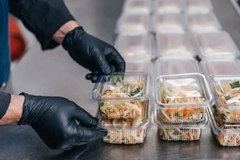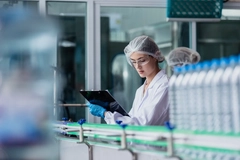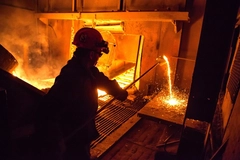Filling machine manufacturers talk “game changing” advances in automation and reduced emissions
17 May 2023 --- Filling machines are increasing in speed and efficiency from consumers demanding automatic packaging systems to keep up with labor shortages while improving eco-friendly practices.
PackagingInsights investigates trends in automatic filling machines hearing from Syntegon about what was showcased at Interpack 2023. Oguz Karcier, product manager at Ampack, a Syntegon company, tells us that dynamic markets and ever-changing consumer needs are challenging for the entire packaging industry, with filling machines also being impacted.
“Besides highly automated machines that help manufacturers tackle the issue of skilled labor shortages, flexibility and [environmental] sustainability are two major trends in liquid food packaging,” says Karcier.
According to reports, the filling machines market is expected to grow at a CAGR of 4.31% by 2028. The regions with the highest growth rates are Asia and Australia, with Europe following.
It is documented that due to the growing demand for fast-moving consumer goods and pharmaceuticals, manufacturers are working to increase the speed of their production lines. There is a growing need for automatic filling machines to quickly fill materials while maintaining volumetric and weight accuracy.
Top customer trend
Filling machines are designed to fill product materials into containers, such as bags, pouches, sachets, plastic bottles, glass bottles, metal bottles, jars, cups and cans. The filling can be granule, powder, liquid or paste.
Syntegon has over 90 years of experience filling machines with its subsidiaries Ampack and Osgood. The company says its customers have trend-related requests such as demand for environmentally sustainable materials.
Syntegon’s LFS saves floor space, which Schubert calls a trend in filling machines (Image credit: Syntegon).“Together with [our customers], we develop customized solutions for their production environments and test them in our laboratories and the field,” explains Karcier.
Syntegon continues that it can overcome challenges and provide manufacturers with “innovative solutions that make their liquid filling equipment ready for the future.”
To stay current with filling machine trends, Syntegon says it developed its Ampack FCL and LFS liquid filling machines offering a flexible design. The machine’s modular design allows manufacturers to react quickly to changing market requirements and process various products.
The LFS filling machine offers a flexible solution for filling and packaging products like deli salads, dips and spreads, while the Ampack FCL filling machine uses hydrogen peroxide or chemical-free alternatives such as pulsed light to disinfect packaging material safely.
Innovations for flexibility and accuracy
The packaging machine manufacturer recently introduced a new electronic concept for its LFS liquid filling system. Its integrated electric cabinets allow the machine to offer a compact footprint with a quick start-up.
“Besides saving shop floor space, the LFS’ new concept also reduces power consumption, reducing the equipment’s environmental impact. The machine offers Syntegon customers additional [environmental] sustainability with innovative sealing heads that take the future requirements of processing cups and lids made of [environmentally] sustainable materials into account,” continues Karcier.
Another innovation is the Syntegon SmartFill dosing concept which combines high flexibility with filling accuracy. To fill products with different viscosities on the same machine, operators can replace the nozzles inside the machine for product changeovers.
“Intermediate rinsing and cleaning are fully automated thanks to a movable and self-draining cleaning bar. The new concept was developed in cooperation with customers and built on proven technologies – this is why upgrading the SmartFill dosing units is possible according to future requirements.”
Filling at Interpack
At Interpack 2023, Schubert Group demonstrated a compact filling line developed for cosmetic manufacturer Börlind.
Marcel Kiessling, managing director of sales and service at Schubert, told PackagingInsights that two Schubert cobots automatically feed individual packaging components to the machine via pick and place. Using a Hygienic Design Standard-compliant transport system, the packaging materials are transferred to two alternating filling stations in a space-saving way.At Interpack 2023, Schubert speaks on its compact filling machine for cosmetics.
“We’re using the cobots as well for a very small and compact cosmetic filling engrossing machine, where we are feeding the bottles, the pumps, the caps for the products into the TLM [modular packaging] machine where they are being filled,” said Kiessling.
On a compact two-by-four-meter space, liquid cosmetics can be filled into glass bottles with screw pumps or glass jars with screw caps – then closed, weighed, sealed and checked.
Compactness concerns
Kiessling tells us on the trade show floor that sectors across the packaging industry were visibly reducing lot sizes because the market dynamics require smaller options.
“We trust that our new machine for cosmetic filling and packing, capable of going up to 60 products per minute and with a changeover time of five minutes, could be a game changer in the cosmetics industry regarding footprint and flexibility.”
The fully automated line is suitable for filling liquids such as perfume. The Schubert image processing system also ensures all necessary quality controls, including checking breakage at the edges of the glass jars.
Automatic filling predictions
Karcier tells us that filling technologies can be more efficient and effective by “achieving even the most stringent hygiene levels to guarantee optimal product protection. On the other hand, offering flexibility is equally crucial.”
“Efficient machines should be able to, for example, fill products with different viscosities on the same machine – saving manufacturers valuable time and cost. The Ampack FCL is an example of reaching maximum efficiency thanks to its high automation levels.”
Regarding filling machines’ future, Syntegon predicts that in addition to highly automated lines that compensate for labor shortages, customers looking for constant improvements will increasingly count on digital solutions to enhance their efficiency.
“Digital solutions provide transparency on machine and production data – which helps to derive improvement potential and become even more productive,” concludes Karcier.
By Sabine Waldeck











